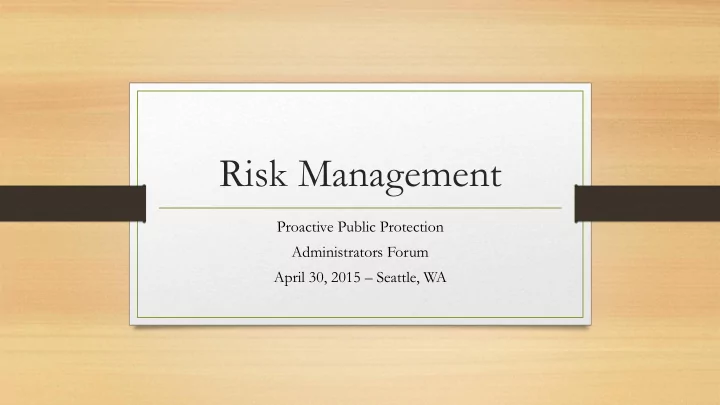

Risk Management Proactive Public Protection Administrators Forum April 30, 2015 – Seattle, WA
What does a “Risk Based” Approach to Regulation Mean? Primary Focus for a Regulator: The Protection of the Public The focus on the public can mean prioritizing risks differently.
Goal of Risk Management Reduce the risk to the public that we are mandated to protect by being PROACTIVE.
Defining Risks Risk is defined as the element of uncertainty in an undertaking. What could possibly go wrong? How could this be better?
Apply Risk Management Principles to Entire Organization Four categories or Quadrants of Risk: 1. Hazard Risks – Physical Safety and Security 2. Operational Risks – Those arising from people 3. Financial Risks – Market forces impacting assets or liabilities 4. Strategic Risks – Societal trends and economic impacts
ASSESS Assess the Risk Who / What are you Regulating? • Does the regulated activity affect a large or small number of the public? • Do you inspect / investigate? • Where is the licensed population – where should resources be focused? • Is an onsite visit necessary?
ASSESS Who/What Continued • What is the average inspection/complaint investigation time? • Are there required response times? • Are there political factors to consider with certain regulated activities ? • What is the compliance history of the targeted group? • Should complaints be prioritized based on risk?
ASSESS Resource Concerns • Adequate number of staff • Location of staff – regionally based, central office, or even home based? • Staff experience • Budget • Geographic limitation of state/province • Law and rules – enforceability issues
Evaluate the Risks Evaluate Goals Understand and prioritize the risks that have been identified. Know the nature of the risk Know as much as possible about the risk under consideration to enhance the quality of the evaluation.
Risk Matrix Evaluate High Severity High Severity Low Frequency High Frequency Low Severity Low Severity Low Frequency High Frequency
Risk Evaluation Evaluate Analyze Controls Identify Consequential Impact Determine unanticipated consequences
Manage the Risks Manage Choose the optimal response to each risk. Start with the highest priority one.
Options to Manage the Risks Manage
5 – 4 – 3 – 2 - 1 Manage 5 – I absolutely love it! 4 – This is a good idea. 3 – I can live with this idea. 2 – I’m not fond of the idea – yet, will support the decision of the team. 1 – I can’t support this idea.
Manage Innovatively Manage • Be innovative in finding solutions to managing each risk. • Have a contingency plan – Plan B
Measure Measure Written Risk Management Plan should include: Who What When
How are you Measuring? Measure • How you will know if you are managing the risk successfully? • What information will be collected as a part of the implementation of the Risk Management Plan? • Collect data that will show the effectiveness of the plan – or where it needs to be modified.
COMMUNICATE ! Measure Internally Externally
Resources Jakovich, Derek J., J.D., M.B.A., M.H.A Manager, Patient Quality Care Unit, Texas Department of State Health Services “Proactive Public Protection: A Risk Based Approach”, Presented at the 2004 CLEAR (Council on License, Enforcement and Regulation) Annual Conference, September 30-October 2, 2004 Steinecke, Richard, J.D . Senior Partner at Steinecke Maciura LeBlanc Law Firm practicing in the field of professional regulation. 401 Bay Street, Suite 2208, P.O. ox 23, Toronto, Ontario “Grey Areas” Newsletter Issues 189 -193, Parts 1-5, Sept. 2014 – February 2015.
Contact Information Jan Fitts, MSW , LCSW, LIMHP Education and Training Senior Manager Association of Social Work Boards 400 Southridge Parkway, Suite B Culpeper, VA 22701 800.225.6880 x 3031
Recommend
More recommend